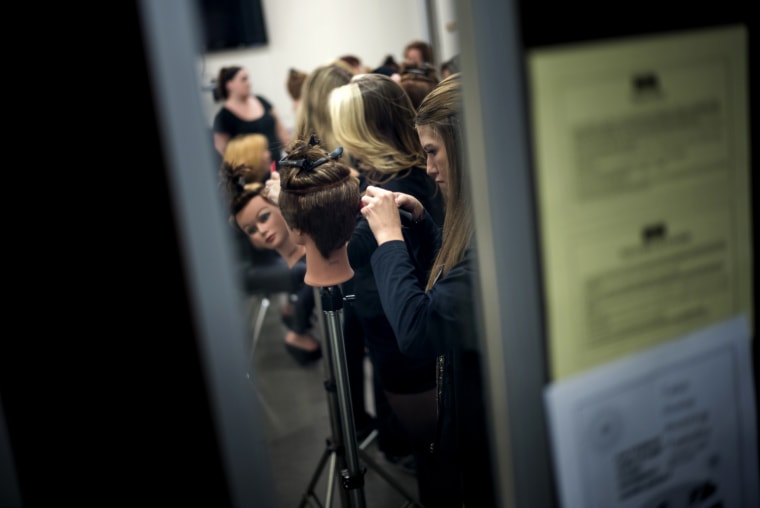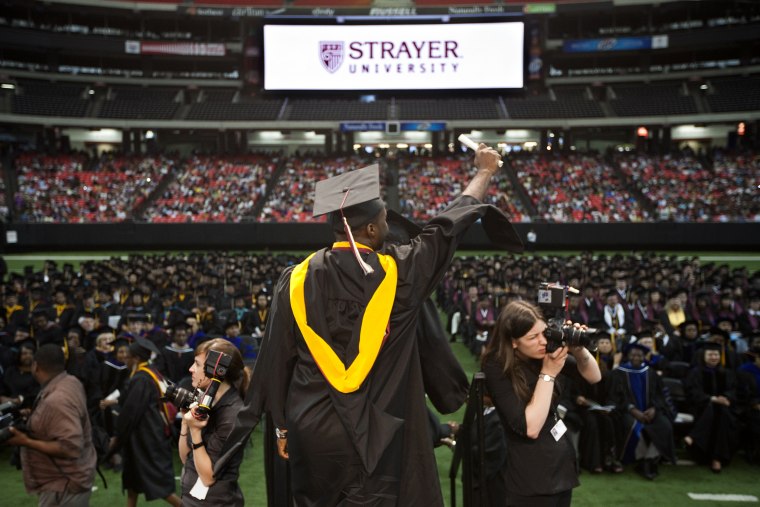Why did the CARES Act give more money to hair schools than to a community college?

Students practice cutting hair at a Paul Mitchell hair school in Virginia in 2013. Paul Mitchell hair schools, which are for-profit businesses, received $30.5 million from the CARES Act, more than many public community colleges that serve several times as many students.
After $14 billion was set aside for higher education in the Coronavirus Aid, Relief and Economic Security Act, Houston Community College and the Paul Mitchell Schools both got financial relief.
The Houston college, a public institution with nearly 60,000 students, received $28.3 million. The for-profit hair and cosmetology schools received $30.5 million, despite serving only 20,000 students.
The CARES Act money was meant to help low-income students and the schools that serve them.
An NBC News analysis found, however, that for-profit schools got proportionally more money from the aid package than the nation’s community colleges, which serve the majority of the country’s low-income students, often at a much lower cost.
Almost 9 percent of the coronavirus relief package money for higher education went to for-profit schools, NBC News found, despite the fact that they serve 5.4 percent of students.
Community colleges, by contrast, got 22 percent though they serve 32 percent of students.
The reason for the disparity is the formula Congress came up with to spend the money. In an effort to funnel aid to students most in need, it put great weight on counting full-time students with Pell grants, the federal grants aimed at low-income students. This meant for-profits did well. Those career-oriented programs tend to be time-intensive and costly, leading more students to attend full-time and to take out federal loans.
“The students in our schools should be just as deserving as those in community colleges,” said Ryan Claybaugh, a vice president at Paul Mitchell Advanced Education, the franchise company for the schools. He said half the money would go directly to students, as required by the CARES Act, and the rest would be spent transitioning the cosmetology schools to online learning.
The fact that half the money going to for-profits can be used for institutional costs concerns critics like Ben Miller, vice president for postsecondary education at the left-leaning Center for American Progress think tank.
‘Unrealistic’ for colleges and universities to reopen this fall: Fmr. Education Secretary
“A dollar that goes to the operating expenses of a for-profit college is a dollar that doesn’t go to helping a community college student pay rent,” Miller said. “I don’t think that makes sense.”
The Students Most In Need
There’s no doubt that students at for-profits are in need. They are disproportionately low income, often supporting families while training for jobs such as licensed practical nurse, car mechanic or long-haul truck driver. They aspire to the kinds of occupations deemed essential during the coronavirus lockdown.
In 2016, 73 percent of those who attended for-profits lived at or near the poverty line, according to a recent congressional report. At some for-profits, more than 80 percent of students are full-time Pell grant recipients, according to data and education experts. That favored them in the CARES Act formula.
“We win because we serve lower income people,” said Steve Gunderson, president and CEO of Career Education Colleges and Universities, or CECU, a trade group that represents for-profit and career colleges.
Community colleges serve a similar population. Nearly 60 percent of their students are low income. Due to the size of the system, community colleges serve more low-income students than any other type of higher educational institution in the country.
Community colleges offer many of the same programs as for profits — more cheaply — and would have done better had the CARES Act formula relied on counting every student.
But they came up short in the formula, because about 64 percent of community college students attend part time. Moreover, because fees are lower, many don’t take out federal loans.
Their focus on short term and workforce programs hindered them, too. They don’t have graduate students, which the formula counts, but they do have large numbers of students in certificate programs. While these noncredit students use the same counseling and career services at the school as full and part-time students, many are uncounted in the formula.
“The formula does not really capture our true student universe,” said J. Noah Brown, president of the Association of Community College Trustees, one of two main associations for community colleges.
Community colleges may also have come up short because all the public and nonprofit colleges, both two-year and four-year, are essentially lobbying as a block. The fiscal crisis means there’s a rush on federal funds — states, hospitals, K-12 schools all need them — so nonprofit and public higher education presented a united front to Congress.
Community colleges spoke up in the negotiations, Brown said. “We certainly made our opinions known,” he said, but ultimately the whole sector came to an agreement because speed was paramount.
That public colleges didn’t push for the money flow to them through states, which many argue serves them better, “is very telling about their shared nervousness about the moment,” said Clare McCann, deputy director for federal higher education policy with New America, a left-leaning think tank.
McCann said that fear may play into why for-profits were able to get funding. “In their desperation, other sectors were not willing to fight back,” she said. One concession was that online-only schools, many of which are for-profit, wouldn’t get funds.
But some tiny schools that don’t need help might. Secretary of Education Betsy DeVos recently came under fire when her department released guidelines that allocated hundreds of thousands of dollars from a CARES Act fund for schools with the “greatest unmet need” to small colleges with few students — without first figuring out if they really need it.
Colleges weigh how to reopen as frustrated students file suit
The allotment was done according to the law, department press secretary Angela Morabito said in an email. “Any school that is eligible for funding under the CARES Act, but does not need it, shouldn’t apply for it,” she said.
The Education Department also barred any student who is ineligible for federal loans from getting the CARES Act relief money, cutting out undocumented and foreign students, as well as those in noncredit programs and without high school diplomas. California community colleges are suing over that restriction, which the Education Department has defended.
“U.S. taxpayer dollars should go to U.S. citizens,” Morabito said. “It’s hypocritical for some liberals in Congress to claim foreign students were meant to get this aid, considering they didn’t write such a requirement into the law.”
The drive to move quickly led to controversy across coronavirus relief programs. Flawed formulas led little-used rural airports to do better than the nation’s leading hubs. Well-capitalized corporations with access to Wall Street have got money designed to help small businesses, despite concerns raised by Secretary of the Treasury Steven Mnuchin.
“The intent of this money was not for big public companies that have access to capital,” Mnuchin said of the business bailout program.
Publicly Traded Schools Get Millions
Universal Technical Institute, Inc., which is traded on Wall Street, runs what it describes the leading technical schools for those looking to become mechanics. Thanks to a large number of Pell grant recipients among its approximately 11,000 students, three of its schools were together the top for-profit recipients of CARES Act aid. The Universal Technical Institute schools received more than $33 million in aid.
The University of Florida, a public university with about 35,000 undergrads, got $2 million less.
Jody Kent, Universal Technical Institute’s vice president for communications, said that the school has begun distributing the first half of its money to students. It’s waiting to receive guidance on how the second half can be spent when it arrives, Kent said, but has committed “that this money will go directly to meeting the needs of our students, so they continue to have resources in place to receive a quality education that puts them on the path to career success.”

Asked to clarify whether the second half of the funds would also go to student grants, Kent said the school is waiting on guidance from the Education Department.
NBC News reached out to six schools operated by companies traded on Wall Street to ask how they planned to use the funds.
The director of public relations for Adtalem Global Education, which operates Chamberlain University, said 100 percent of the funds it received would go directly to students.
A spokesperson for Strategic Education, Inc., the parent company of Strayer University, said it declined its $5.8 million because its school is largely online.
Some privately held for-profits are drawing scrutiny as well, with critics arguing that many of the needy students that help them qualify for aid were reeled in by coercive practices.
Florida Career College, a for-profit vocational and trade school, is slated to receive more than $17.3 million in CARES Act funds.
But a lawsuit filed in April accuses the school of targeting black students with high-pressure tactics that left them deeply in debt.
Only one of the school’s 17 programs passes the federal measure of whether what graduates earn can cover their loans and basic needs, according to a class-action suit filed by Harvard Law School’s Project on Predatory Student Lending. After graduating, students able to find jobs in the area they studied earn between $9,000 and $33,000, the lawsuit claims.
“I don’t think the government should be giving taxpayer dollars to companies whose business model is cheating students,” Toby Merrill, director of the Project on Predatory Student Lending, said.
Florida Career College said it could not comment on specifics of the lawsuit due to pending litigation, but called it “baseless legally and factually.”
“We will aggressively fight these false allegations,” Aaron Mortensen, the college’s general counsel, said in an email. FCC said it has pledged to pass along 100 percent of the funds it receives to its students.
Research shows for-profits have been a key driver of the crippling student debt crisis, with higher costs and worse outcomes. Some Democratic legislators have called for barring them from receiving the same federal loans that allowed about 1,600 for-profits to collectively receive more than $1 billion in coronavirus bailout funds.

But the Trump administration’s Education Department has been supportive of them, including rolling back Obama-era rules meant to crack down on the worst-performing schools, instead encouraging greater transparency.
Robert Kelchen, an associate professor of higher education at Seton Hall University, said he’s not surprised for-profits are being careful.
“The for-profits know that how they use the money is going to be scrutinized,” he said. “I think they’re using the money they have discretion over in a reasonable way because they don’t want an investigation before Congress.”
A fourth round of bailout funds in a bill passed last week in the House of Representatives would include another $37 million for higher education. It would earmark $27 billion in state funds for public colleges, which those on the left have called for, and come closer, though would not meet, the level of funding higher education experts say is crucial to keeping institutions afloat.
The bill is unlikely to make it through the Senate. Many conservatives don’t believe more bailouts are the right answer.
“We should be a lot more skeptical of those,” said Preston Cooper, visiting fellow at the Foundation for Research on Equal Opportunity, a right-leaning think tank. “I think colleges should have to demonstrate pressing need before we spend more money.”
The House bill largely cuts out for-profit institutions from the funding. Gunderson of CECU said he believes if more money does come through for higher education, for-profit career schools will get a slice.
“If there is more student aid,” Gunderson said, “I’m certain we will be included.”
Source: NBCNEWS
